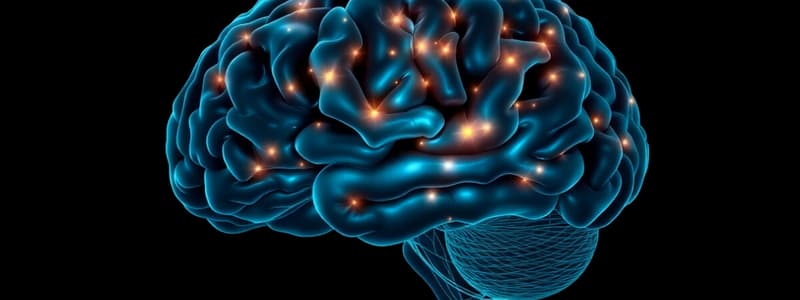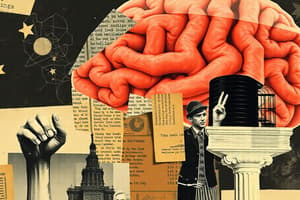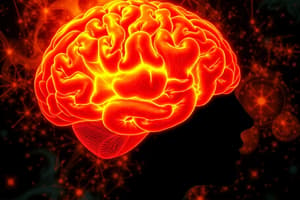Podcast
Questions and Answers
Which brain structure is MOST directly involved in generating emotional responses?
Which brain structure is MOST directly involved in generating emotional responses?
- Motor cortex
- Parietal lobe
- Limbic system (correct)
- Cerebellum
What is the PRIMARY role of emotions from a biological perspective?
What is the PRIMARY role of emotions from a biological perspective?
- To complicate decision-making processes.
- To provide subjective experiences without adaptive function.
- To serve as survival mechanisms by encouraging behaviors necessary for species survival. (correct)
- To hinder rational thought and actions.
The perception of emotion involves signals from the amygdala to what area of the brain?
The perception of emotion involves signals from the amygdala to what area of the brain?
- Cerebellum
- Frontal cortex (correct)
- Occipital lobe
- Temporal lobe
The indirect pathway in emotional processing involves the hypothalamus communicating with what system to produce physical changes?
The indirect pathway in emotional processing involves the hypothalamus communicating with what system to produce physical changes?
What behavior is MOST characteristic of monkeys displaying Kluver-Bucy syndrome following damage to the medial temporal lobe?
What behavior is MOST characteristic of monkeys displaying Kluver-Bucy syndrome following damage to the medial temporal lobe?
What is the PRIMARY function of the amygdala in the context of emotional learning?
What is the PRIMARY function of the amygdala in the context of emotional learning?
A patient with bilateral damage to the amygdala (Patient SM) would MOST likely have difficulty with what task?
A patient with bilateral damage to the amygdala (Patient SM) would MOST likely have difficulty with what task?
According to the James-Lange theory, how do emotions arise?
According to the James-Lange theory, how do emotions arise?
What is the significance of studying animals with lesions to the cerebral cortex but with an intact hypothalamus?
What is the significance of studying animals with lesions to the cerebral cortex but with an intact hypothalamus?
What does the Autonomic Nervous System (ANS) do in the context of emotion?
What does the Autonomic Nervous System (ANS) do in the context of emotion?
What is the MOST likely effect of a spinal cord injury on the perception of emotions?
What is the MOST likely effect of a spinal cord injury on the perception of emotions?
What was the result of frontal lobotomies on patients?
What was the result of frontal lobotomies on patients?
How do the frontal lobes relate to emotional responses initiated by the amygdala and hypothalamus?
How do the frontal lobes relate to emotional responses initiated by the amygdala and hypothalamus?
Why might children be more prone to tantrums than adults?
Why might children be more prone to tantrums than adults?
Which neurotransmitter is MOST commonly linked to depression?
Which neurotransmitter is MOST commonly linked to depression?
What role does the amygdala play in happiness?
What role does the amygdala play in happiness?
In MOST individuals, the right hemisphere is particularly important for what aspect of emotional processing?
In MOST individuals, the right hemisphere is particularly important for what aspect of emotional processing?
Patients with lesions to the left hemisphere are more likely to experience what condition?
Patients with lesions to the left hemisphere are more likely to experience what condition?
Darwin proposed what regarding emotional expression?
Darwin proposed what regarding emotional expression?
What is associated with synchronized gamma rhythms (bursts of 30-80Hz) in areas across the cortex?
What is associated with synchronized gamma rhythms (bursts of 30-80Hz) in areas across the cortex?
Flashcards
What are Emotions?
What are Emotions?
Survival mechanisms that drive behaviors like eating, defending against danger, and reproducing.
Limbic System
Limbic System
Brain area primarily involved in generating emotional responses, rooted deep in our evolutionary past.
Amygdala's Role
Amygdala's Role
Relaying emotional stimuli via direct and indirect signals to the frontal cortex.
Indirect Path
Indirect Path
Signup and view all the flashcards
Klüver-Bucy Syndrome
Klüver-Bucy Syndrome
Signup and view all the flashcards
Amygdala's Role in Survival
Amygdala's Role in Survival
Signup and view all the flashcards
Innate Fear Response
Innate Fear Response
Signup and view all the flashcards
Learned Fear Association
Learned Fear Association
Signup and view all the flashcards
Amygdala Damage (SM)
Amygdala Damage (SM)
Signup and view all the flashcards
James-Lange Theory
James-Lange Theory
Signup and view all the flashcards
Hypothalamus' Role
Hypothalamus' Role
Signup and view all the flashcards
Sham Rage
Sham Rage
Signup and view all the flashcards
Autonomic Nervous System (ANS)
Autonomic Nervous System (ANS)
Signup and view all the flashcards
Spinal Injury Impact On Emotions
Spinal Injury Impact On Emotions
Signup and view all the flashcards
Prefrontal Cortex Lesions
Prefrontal Cortex Lesions
Signup and view all the flashcards
Frontal Lobes' Inhibitory Role
Frontal Lobes' Inhibitory Role
Signup and view all the flashcards
Happiness
Happiness
Signup and view all the flashcards
Affective (Mood) Disorder
Affective (Mood) Disorder
Signup and view all the flashcards
Meditation
Meditation
Signup and view all the flashcards
Study Notes
- Emotions are subjective feelings that influence behavior, with examples including anger, fear, disgust, sadness, and happiness.
- Emotions are survival mechanisms present in all animals, encouraging actions necessary for survival and reproduction.
- Brain systems generating emotional behaviors are rooted in evolutionary history, and the limbic system is primarily involved in generating emotional responses.
Emotional Responses
- Emotional stimuli range from everyday events to threatening situations.
- Sensory systems relay stimuli to the amygdala.
- The perception of emotion arises from both direct and indirect signals between the amygdala and the frontal cortex.
- The indirect path involves the hypothalamus, which communicates with the autonomic nervous system to produce physical changes like increased heart rate.
- Physical changes are fed back to the frontal cortex for interpretation of emotion.
Amygdala's Role
- The amygdala is part of the limbic system.
- Studies on lesioned amygdalas show the amygdala's role in emotional behavior.
- Kluver-Bucy syndrome, resulting from medial temporal lobe damage, causes tameness, loss of fear and aggression, examination of objects by mouth, increased sexual activity, and visual agnosia.
- A key symptom is the loss of fear, as demonstrated by monkeys handling snakes without aversion.
Emotional Memory
- The amygdala minimizes contact with dangers to improve survival chances.
- Awareness of danger is both innate and learned.
- An example of innate fear is a rat's fear response to the odor of a ferret, even without prior exposure.
- An experiment demonstrated that pairing a tone with an electric shock can result in the animal showing fear to the tone alone, showcasing the amygdala's role in linking neutral stimuli to threats.
Human Amygdala
- A case study (patient SM with bilateral amygdala damage) shows the amygdala's role in human emotional experience.
- SM had difficulty rating the intensity of emotions on photos, especially anger and fear.
- SM was unable to sketch a face displaying fear but could recognize and draw positive emotions like happiness.
Feelings and the Amygdala
- The question is posed whether amygdala activity alone is sufficient to feel emotion.
- The common-sense view was that changes in body state caused emotion.
- William James argued that emotions result from changes in body state, known as the James-Lange theory.
Hypothalamus
- The hypothalamus contains neurons that control body functions and receives connections from the amygdala.
- Studies involving animals with lesions to the cerebral cortex but an intact hypothalamus were very aggressive to any external stimulus.
- Interpreting emotional states requires an intact cerebral cortex.
Body State and Emotion
- The autonomic nervous system (ANS) receives input from the hypothalamus.
- The sympathetic nervous system prepares the body for action.
- The parasympathetic nervous system has the opposite effect on the body.
- The ANS has motor and sensory neurons; sensory neurons report physiological changes in the body caused by motor neurons.
Spinal Injury
- Changes in body state are vital for perceiving emotion.
- Patients with spinal-cord injury experience decreased perceived emotion, with severity correlating to the lesion's location.
Prefrontal Cortex
- Experiments in the 1930s showed that lesions to monkey frontal lobes resulted in more relaxed behavior.
- Egas Moniz used a similar procedure to treat behavioral disorders in humans, known as a frontal lobotomy or frontal leukotomy, which alters personality and removes the ability to understand emotions.
- Emotional responses are a function of rational decision making.
Amygdala, Hypothalamus & Frontal Lobes
- Emotional responses are initiated by the amygdala and hypothalamus before information reaches the frontal lobes.
- Frontal lobes can reduce or inhibit emotional responses, if unwarranted.
- Tantrums in children occur because of undeveloped connections between the frontal lobes and limbic system which can lead to phobias if these connections fail to develop in adults.
Neurotransmitters
- Happiness comes from a rush of dopamine in the reward system, triggered by sensory or sexual stimuli or by simply being with someone you love.
- It relies on an absence of negative emotion, for which the amygdala is responsible.
- Affective disorders, including depression, feature abnormal regulation of sadness and happiness and involve connections between the amygdala and prefrontal cortex.
- Depression is linked to decreased levels of serotonin.
Cerebral Hemispheres
- Emotionality is lateralized in the cerebral hemispheres two ways
- The right hemisphere is vital for expressing and understanding emotional aspects of speech.
- The left hemisphere is associated with positive emotions, while the right is more involved with negative ones.
- Lesions to the left hemisphere correlate with an increased incidence of depression, and patients with lesions to the right hemisphere appear unduly cheerful.
Face Expression
- Emotions are expressed in facial movements.
- Different facial expressions indicate happiness, anger, sadness, and fear.
- Darwin proposed that emotional expression is inherited, based on evidence that those responses are similar across cultures.
- Neurons that control face muscles receive input from the cerebral cortex and limbic system.
- Smiling for the camera produces an unnatural smile, while genuine happiness evokes a more symmetrical smile driven by the limbic system.
Monks and Control
- Tibetan monks use meditation to rid themselves of negativity.
- Those meditating can triple gamma-wave activity in the frontal and parietal-temporal regions.
- Synchronized gamma rhythms (bursts of 30-80Hz) across the cortex is associated with binding neural components into a perceptual construct.
Studying That Suits You
Use AI to generate personalized quizzes and flashcards to suit your learning preferences.




